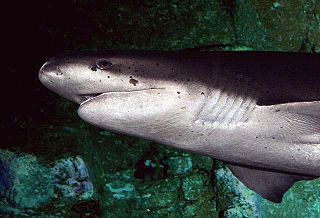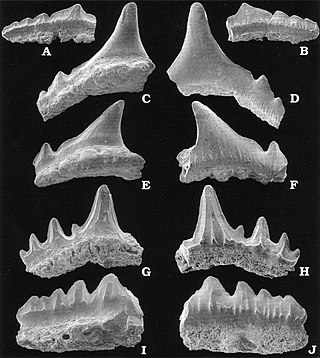
Carcharhiniformes, the ground sharks, are the largest order of sharks, with over 270 species. They include a number of common types, such as catsharks, swellsharks, and the sandbar shark.

The Hexanchiformes are a primitive order of sharks, that numbering just seven extant species in two families. Fossil sharks that were apparently very similar to modern sevengill species are known from Jurassic specimens.

The Lamniformes are an order of sharks commonly known as mackerel sharks. It includes some of the most familiar species of sharks, such as the great white, as well as more unusual representatives, such as the goblin shark and megamouth shark.

Squalicorax, commonly known as the crow shark, is a genus of extinct lamniform shark known to have lived during the Cretaceous period. The genus had a global distribution in the Late Cretaceous epoch. Multiple species within this genus are considered to be wastebasket taxon due to morphological similarities in the teeth.

Sclerorhynchus is an extinct genus of ganopristid sclerorhynchoid that lived during the Late Cretaceous. The genus Ganopristis is considered a junior synonym of Sclerorhynchus. It was a widespread genus, with fossils found in the Middle East, North Africa, Europe, and North America. While it had a long rostrum with large denticles similar to sawfishes and sawsharks, its closest living relatives are actually skates. Complete specimens of S. atavus show that its fin arrangement was similar to skates, with the pectoral and pelvic fins touching, both dorsal fins located behind the pelvic fins, and a reduced caudal fin.

Archaeopterygidae is a group of maniraptoran dinosaurs, known from the latest Jurassic and earliest Cretaceous of Europe. In most current classifications, it contains only the genera Archaeopteryx and Wellnhoferia. As its name suggests, Protarchaeopteryx was also once referred to this group, but most paleontologists now consider it an oviraptorosaur. Other referred genera, like Jurapteryx, Wellnhoferia, and "Proornis", are probably synonymous with Archaeopteryx or do not belong into this group. Jinfengopteryx was originally described as an archaeopterygid, though it was later shown to be a troodontid. A few studies have recovered Anchiornis and Xiaotingia to also be members of the Archaeopterygidae, though most subsequent analyses have failed to arrive at the same result. Uncertainties still exist, however, and it may not be possible to confidently state whether archaeopterygids are more closely related to modern birds or to deinonychosaurs barring new and better specimens of relevant species. Teeth attributable to archaeopterygids are known from the earliest Cretaceous (Berriasian) Cherves-de-Cognac locality and the Angeac-Charente bonebed of France.
Meristodonoides is an extinct genus of hybodont. The type species is M. rajkovichi, which was originally a species in the genus Hybodus. The species, along with other Hybodus species such as H. butleri and H. montanensis, was reassigned to Meristodonoides by Charlie J. Underwood and Stephen L. Cumbaa in 2010. The species is primarily known from remains from the Cretaceous of North America, spanning from the Aptian/Albian to Maastrichtian, making it one of the last surviving hybodont genera, though records of the genus likely extend back as far as the Late Jurassic, based on an undescribed skeleton from the Tithonian of England, and fragmentary teeth from the Kimmeridgian of Poland, England and Switzerland. Other remains of the genus are known from the Coniacian of England, and the Aptian-Albian of France. The morphology of the teeth suggests an adaptation to tearing prey. Fossils from the Western Interior Seaway suggest that it preferred nearshore marine environments, being absent from deeper-water areas, with it likely also being able to tolerate brackish and freshwater conditions.

Cretalamna is a genus of extinct otodontid shark that lived from the latest Early Cretaceous to Eocene epoch. It is considered by many to be the ancestor of the largest sharks to have ever lived, such as Otodus angustidens, Otodus chubutensis, and Otodus megalodon.
This list of fossil fishes described in 2013 is a list of new taxa of placoderms, fossil cartilaginous fishes and bony fishess of every kind that have been described during the year 2013. The list only includes taxa at the level of genus or species.

The Oulad Abdoun Basin is a phosphate sedimentary basin located in Morocco, near the city of Khouribga. It is the largest in Morocco, comprising 44% of Morocco's phosphate reserves, and at least 26.8 billion tons of phosphate. It is also known as an important site for vertebrate fossils, with deposits ranging from the Late Cretaceous (Cenomanian-Turonian) to the Eocene epoch (Ypresian), a period of about 25 million years.

Pseudocorax is an extinct genus of mackerel sharks that lived during the Late Cretaceous. It contains six valid species that have been found in Europe, the Middle East, North Africa, and North America. It was formerly assigned to the family Anacoracidae, but is now placed in its own family Pseudocoracidae along with Galeocorax. The former species "P." australis and "P." primulus have been reidentified as species of Echinorhinus and Squalicorax, respectively.

Synechodontiformes is an extinct order of prehistoric shark-like neoselachians, known from the Permian to the Paleogene. They are considered to be members of Neoselachii, the group that contains modern sharks and rays.

Paracestracion is an extinct genus of heterodontiform sharks from Early Jurassic to Early Cretaceous-aged rocks of England, France, Germany and Luxembourg. The genu was first described in 1911 by Ernst Hermann Friedrich von Koken in Karl Alfred von Zittel.

Paraisurus is an extinct genus of mackerel sharks that lived during the Cretaceous. It contains four valid species, which have been found in Europe, Asia, North America, and Australia. A fifth species, P. amudarjensis, is now considered a synonym of P. compressus. While this genus is mostly known from isolated teeth, an associated dentition of P. compressus was found in the Weno Formation of Texas. It went extinct around the Albian-Cenomanian boundary, as a supposed Coniacian occurrence of "P. sp." is likely a misidentified pseudoscapanorhynchid.
Eoptolamna is an extinct genus of mackerel sharks that lived during the Cretaceous. It contains two valid species, E. eccentrolopha and E. supracretacea, which have been found in Europe and North Africa.
Galeocorax is an extinct genus of mackerel sharks that lived during the Late Cretaceous. It contains a single valid species, G. jaekeli, that has been found in Europe and North America.

Propristiophorus is an extinct genus of sawshark that lived in the Late Cretaceous. It contains a single named species, P. tumidens, from Lebanon. Additional unnamed species have been found in Antarctica, Japan, and Madagascar. Propristiophorus was previously synonymized with Pristiophorus, but more recent authors have considered it a distinct genus.
Hessinodon is an extinct genus of possible kitefin sharks that lived during the Late Cretaceous. It contains one valid species, H. wardi, which is known from four teeth from the Northumberland Formation of British Columbia. Its teeth are most similar to those of modern cookiecutter sharks.
Dallasiella is an extinct genus of mackerel sharks that lived during the Late Cretaceous. It contains two valid species, D. willistoni and D. brachyodon, which have been found in North America and Europe. While formerly placed in the families Cretoxyrhinidae and Archaeolamnidae, it is now considered Lamniformes incertae sedis.

Pseudocoracidae is a family of extinct mackerel sharks that lived during the Late Cretaceous. It includes two genera, Galeocorax and Pseudocorax.












